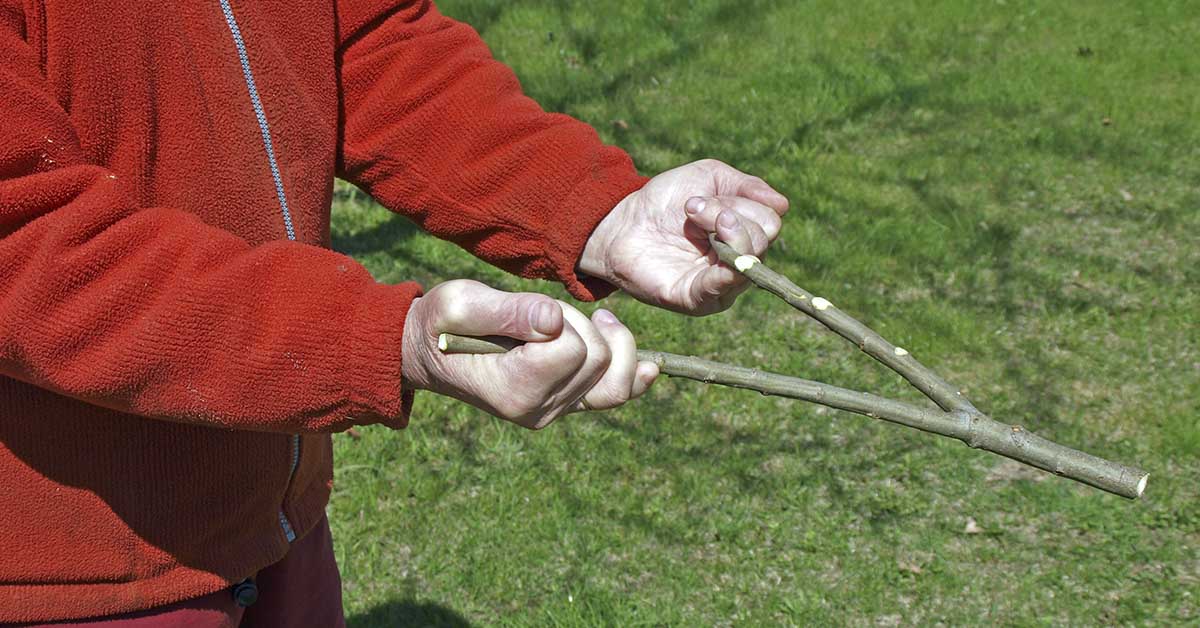There is very little known about the history of water dowsing. Some speculate that it can be a useful method, while most scientists would wholeheartedly disagree. The method has been used worldwide, from Australia to India to Europe, and is thought to have originated some 8,000 years ago. Lastly, it has been thought to serve a valuable purpose in helping homesteaders pioneer America. The antique tool, also known as a water-dowsing stick or rod is something that many of us today wouldn’t recognize. Let alone would we know it was used to look for underground water sources.
An Antique Tool With an Interesting History
Researchers found petroglyphs on cave walls in Tassili, thought to be around 8,000 years old. These caves are part of the Sahara Desert in Northern Africa. The pictures portray tribesmen circled around a man holding a forked stick. The official origins are unknown, but many speculate that these depictions are the first documented acknowledgment of water dowsing.
Sometime later the emergence of ancient artwork from both Egypt and China showed people using forked tools, also thought to be water dowsing. In Biblical times, there is mention of both Moses and Aaron using a “rod” to locate water. The first official written account of the use of this antique tool was the Middle Ages when dowsers in Europe were looking for coal deposits.
Dowsing has been used to help search for wells, mineral deposits, oil, and even buried treasure. Some people have even used the tool to help locate missing persons.
Read: Agriculture: The Worst Mistake Humans Ever Made?
How Water Dowsing is Thought to Work
In addition to speculation around its origins, there is not much clarity as to how water-dowsing sticks work. There has been much debate about how this antique tool works but some believe that everything has energy. Those who practice the method, postulate a psychic connection between the person using the tool and the item of which they are in search. The user concentrates on these hidden items and tunes into the energy of the item. The tool is thought to act as an antenna to amplify and tune into the item’s energy. This then, allegedly, causes the stick to move in the direction of the missing item. Sounds pretty advanced for such an antique tool.
Insight From a Water Professional
Todd Jarvis is an engineering geologist and Director of the Institute for Water & Watersheds at Oregon State University. He is a water rights examiner and mediator and has some experience with this antique tool. For those who don’t know, water rights are laws that refer to a user’s right to use water from a source such as rivers, streams, ponds, or groundwater. These vary from state to state and Jarvis’ job includes inspecting and verifying water use.
In his case, for Corvallis, Oregon, and other surrounding cities. There are 54 Resource Research Institutes throughout the U.S. and its territories. Jarvis has more than 35 years of experience in the groundwater engineering industry, including writing a book. His book is called Contesting Hidden Waters: Conflict Resolution for Groundwater and Aquifers.
Jarvis was previously a member of the American Society of Dowsers which was his first and only experience as a dowser. Jarvis has regularly encountered “dowsers” throughout his career, despite his own limited experience with the antique tool.
Read: Young Boy Buys Painting for $2. Eyes Pop When Told True Worth On ‘Antiques Roadshow’
Scientist Says
Jarvis believes geologists and other scientists (including hydrologists) are more adept at finding water. He goes on to say that witches are more trusted than scientists by farmers and landowners. In fact, one estimate claims there are around 60,000 water dowsers in America today. That’s roughly 10 times as many hydrologists.
Hydrologists provide the same services as these “water dowsing witches” by using scientific evidence to seek out bodies of water underground. Hydrologists measure bodies of water, by volume and stream flow. They also collect water and soil samples to test for things like pH balance or pollutants. Additionally, these scientists analyze data on the environmental impact of pollution, erosion, or droughts. Some landowners recruit the services of both “dowsers” and scientists to ensure they’ve covered all their bases.
A number of water dowsers use both scientific research and divining methods to seek out underground water. They look at the topography of the land. Defined as “an arrangement of natural and artificial physical features” of the land. They also view and draw their own maps, implying that they may understand local aquifers.
While some dowsers have had success using these water dowsing sticks, scientists state it’s just statistics. There’s so much underground water and places with substantial rainfall. Scientists believe these areas would be hard to miss. Thereby creating high success rates for “dowsers”. However, according to the United States Geological Survey, the process of finding underground water is a complicated and involved process.
“To locate ground water accurately, as to depth, quantity and quality, a number of techniques must be used. Hydrologic, geologic, and geophysical knowledge is needed to determine the depths and extent of the different water-bearing strata and the quantity and quality of water found in each. The area must be thoroughly tested and studied to determine these facts.“[5]
An Alternative Method
As you have figured out by now, the antique tool in question is a water-dowsing stick, and they have a long-standing history. This in itself makes it something exciting. Additionally, given the success rate of the method it’s also worth exploring in case you find yourself needing tips on how to find water in your area. For those who may feel skeptical of the method, HowStuffWorks created an article in which they explain water survival.
Updated last year, it contains some valuable information including how to find water if you’re stranded in the wilderness, and how to collect said water. They also cover the importance of purifying water and methods for how to do so.
Keep Reading: Veteran Goes On ‘Antiques Roadshow’ To Get Rolex Appraised, Collapses After Learning Value
Sources
- “Todd Jarvis.” Oregon State University. Retrieved November 1, 2022.
- “The bizarre history of dowsing rods.” Grunge. Tom Meisfjord. July 28, 2020.
- “California Water Witches see big business as the drought drags on.” The Guardian. Mary Catherine O’Connor. September 15, 2014.
- “Water dowsing.” PUBS. Retrieved November 1, 2022.
- “The Divining Rod.” UCANR. Arthur J. Ellis. Retrieved November 1, 2022.
- “WELCOME TO THE AMERICAN SOCIETY OF DOWSERS.” Dowsers. Retrieved November 1, 2022.
- “All About Dowsing.” Live About. Stephen Wagner. February 24, 2019.
- “Water dowsing completed.” USGS. Water Science School. June 6, 2018.

